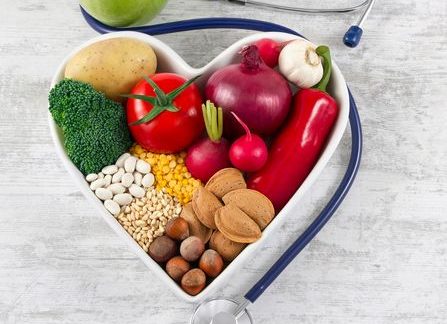We’ve been told for decades to avoid foods with high cholesterol because they’re clogging our arteries, but do you actually know what cholesterol is? According to a study by Healthspan (healthspan.co.uk), 77 percent of people don’t understand the different types – or know that there are good and bad versions. And with up to 68 percent of British women having raised cholesterol levels, it’s an important issue to address. We called in the experts to give us a beginner’s guide to this misunderstood lipid.
A vital role
“Cholesterol is a word which gets thrown around a lot and is often associated with negative connotations, but it’s important to understand that this fat plays a key role in many important functions of the body,” says nutritionist Jenna Hope (jennahopenutrition.com). “Not only does it allow the body to produce hormones required for everyday physiological function, but it also supports digestion as it stimulates the production of bile, helping to break down the individual nutrients in the food you’re eating. If that wasn’t enough, it aids your cells too – cholesterol contributes to the building of a cell structure and helps to create an external protective layer.” But how is it in our bodies in the first place? “Everyone has cholesterol, and it’s not necessarily a bad thing,” explains Fiona Hunter, nutritionist at Healthspan (healthspan.co.uk). “Most of the cholesterol in our blood is made by the body, but it also occurs in some foods. Despite its reputation, not all cholesterol is bad, and it only starts to be a problem when the liver makes too much.”
The good, the bad and the ugly
There are several types of cholesterol, which may sound confusing, but they can be divided into two main groups – one of which is good, the other bad. “HDL-cholesterol (high-density lipoprotein) is the good stuff, while the bad type is called LDL-cholesterol (low-density lipoprotein),” says Fiona. “Raised levels of LDL-cholesterol are linked with an increased risk of cardiovascular disease, while a high level of HDL-cholesterol in the blood is a good thing because it carries LDL away from the tissues to the liver, where it can be excreted.” There are other problems caused by raised LDL-cholesterol levels, too, as Fiona explains. “When the liver makes too much bad cholesterol, it sticks to the walls of the blood vessels, causing them to become narrow and stiff. In the same way that your kettle and water pipes can become clogged with lime-scale, the arteries that supply blood to the heart and the brain can become clogged with bad cholesterol and other fatty substances – a condition the medical profession call atherosclerosis. If the arteries become so furred up that the supply of blood to the heart is reduced, it causes a condition called angina and if the vessel become completely blocked with cholesterol, a blood clot shuts the heart, or the brain become starved of blood and therefore oxygen – this leads to a heart attack or stroke.”
Highs and lows
High cholesterol is caused by a variety of reasons, including a family history of the issue, stress, smoking, a sedentary lifestyle, diet, and being overweight, but how much is too much? Your total level should be below 5mmol/litre for healthy adults, with the LDL amount below 3mmol/litre. Unfortunately, high cholesterol doesn’t cause any symptoms: “Many people have it without realising, and only discover it when they have a blood test,” says Fiona. So, what’s next if you’ve been told you have high cholesterol? “It can leave you feeling scared and lost, but you can help yourself through dietary and lifestyle changes,” says Jenna. “Ask your GP for the LDL/HDL breakdown. Some research suggests that by lowering your LDL by 1mmol/l, you can reduce your risk of cardiovascular disease by 22 percent.” Here are some easy ways from the experts:
Eat at least five portions of fruit and vegetables a day.
“Studies suggest that LDL-cholesterol that has been oxidised is much more readily deposited in the arteries,” says Fiona. “It seems that oxidation changes the structure of the cholesterol, making it much more likely to stick to the blood vessel walls. Fruit and veg are rich in vitamins and other protective compounds that act as powerful antioxidants, helping to prevent the oxidation of LDL and reduce the change of it being deposited in the arteries.”
Try opting for a few meatfree days a week.
“Ensure you’re replacing your meat with high quality plant protein in the form of beans, legumes, pulses and tofu,” says Jenna.
Aim to eat two servings of fish a week.
“Omega 3 fatty acids are found in fish such as salmon and sardines and help to increase HDL-cholesterol,” says Fiona. “They also help to protect the heart by making the blood less sticky and likely to clot, lowering blood pressure and improving blood flow by encouraging the muscles lining the artery walls to relax.”
Have more soluble fibre.
“This is found in oats, oat bran, beans, pulses and some fruit and veg and can help reduce LDL-cholesterol levels by encouraging the body to excrete it before it can be absorbed into the bloodstream,” says Fiona. “Choose a breakfast cereal rich in the nutrient, such as porridge or muesli, or try adding beans and pulses to soups and casseroles.”
Don’t make the mistake of eliminating good fats.
“These are called essential fatty acids for a good reason,” says nutritional physiologist Rick Hay (rickhay.co.uk). “They help with mood, skin health, good cholesterol, joints, brain function, digestive health and weight loss.”
Add more nuts to your diet.
“These are rich in unsaturated fat and other heart-friendly compounds that help reduce LDL and increase HDL,” Fiona says. “A recent study found that people who consume small amounts of peanuts or peanut butter five or more times a week reduced their risk of heart =disease by 50 percent.”
Consider eating foods which are fortified with plant sterols and stanols.
“These help to reduce cholesterol by blocking its absorption into the blood,” says Jenna. “As a result, more cholesterol is excreted and overall your levels are lowered. Try including some fortified foods such as yoghurts and spreads – although its important to be aware that these products can be high in sugar and so shouldn’t be over consumed.”
Try supplements.
“Spirulina, chlorella, olive leaf extract, globe artichoke, milk thistle and algal oil are all good for this,” Rick tells us. “I also recommend dandelion tea or coffee.”
Eat more soya.
“Recent studies have shown that eating 25g soya protein and day can lead to a 10 percent reduction in both total and LDL cholesterol,” explains Fiona.
Spice things up in the kitchen.
“Using turmeric, ginger, rosemary and basil regularly in your cooking will be beneficial,” says Rick.
Have foods high in beta-glucans.
“This is a dietary fibre found naturally in plants,” says Jenna. “Beta-glucans work in a similar way to plant sterols as they prevent the uptake of cholesterol into the blood. Research demonstrated that beta-glucans help to reduce LDL-cholesterol but have no effect on raising HDL-cholesterol. The effects were heightened in those individuals who also suffered from diabetes. Oats are a great source of beta glucans. Try choosing porridge for breakfast to help lower your LDL-cholesterol. Other foods high in beta-glucans include barley, mushrooms and seaweed.”
Drink red wine. Yep, you read that right!
“A moderate intake of alcohol (around one to two glasses a day) has been shown to help increase levels of HDL cholesterol and protect against heart disease,” says Fiona. “This is because red wine is rich in a group of phytochemicals called flavonoids that protect the body against the damaging effects of free radicals. Studies show that they help to prevent the oxidation of LDLcholesterol. Cabernet sauvignon, merlot and pinot noir wines, particularly those from Chile, have been shown to contain much higher levels of flavonoids compared to other types. Other good sources of flavonoids include tea, grapes, onions and apples.”
Engage in regular physical activity.
“Aerobic exercise has been shown to increase HDL which can consequently reduce LDL,” Jenna tells us. “It’s recommended that you engage in 120 minutes of aerobic exercise a week. That doesn’t have to be sweating it out in the gym though – it can be a simple 30-minute walk four times a week.”





















